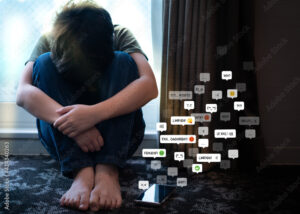“I swear, I was just texting my mom!”
We have all heard the excuses. “I was just texting my mom”, “I was checking to see what time it is”, I thought I left it on”, “I needed to check that it was on silent”, etc. It seems like we were fighting a battle for our students’ attention. The debate surrounding technology usage in classrooms has always existed, but due to smartphones, this debate has intensified. The recent ban on cell phones in Saskatchewan schools has understandably reignited this debate amongst our school communities. While arguments about student well-being and focus are valid, the issue is more complex. We must consider the influence of smartphones on student behaviour, access to technology in schools, school culture, and privacy issues. As a classroom teacher, I see both the rationale behind the ban and the unintended consequences it has created. It is for this reason that I wish the government had held important discussions on the topic with educators before implementing the ban. In reality, the government failed to consider the complexity of this issue and the school division’s technological demands. This conversation needs to address how technology influences student behaviour, school culture, and privacy. Dissecting this situation is the perfect opportunity to explore the issues surrounding the inclusion of cell phones in schools.
Cell Phones as a Technology Bridge
 This ban impacted student access to technology while at school. Many schools in my division operate with limited access to student technology. Provincial budget cuts have made it increasingly difficult to provide each student with regular computer access, as discussed during our class debate. Cell phones have helped bridge this gap. Cell phones aid with digital tasks, such as creating online portfolios, conducting research, using dictionary apps, replacing lost calculators, and engaging with interactive platforms like digital quizzes. Cell phones are not an ideal solution, but they fill the gap in school infrastructure and provide teachers with flexibility for digital activities.
This ban impacted student access to technology while at school. Many schools in my division operate with limited access to student technology. Provincial budget cuts have made it increasingly difficult to provide each student with regular computer access, as discussed during our class debate. Cell phones have helped bridge this gap. Cell phones aid with digital tasks, such as creating online portfolios, conducting research, using dictionary apps, replacing lost calculators, and engaging with interactive platforms like digital quizzes. Cell phones are not an ideal solution, but they fill the gap in school infrastructure and provide teachers with flexibility for digital activities.
However, touchscreen smartphones and iPads have created a skill deficit in students. I began to notice students struggling with basic typing skills. My colleagues and I attempted to address this by encouraging online typing programs as optional activities after completing their work. However, the difficulty with this skill often left students frustrated and disengaged. Furthermore, students tended to use guesswork, if they responded at all, when they couldn’t instantly find the information they needed for their projects. This is due to a multitude of issues, from slow typing skills to issues with key word searches. These issues undermined their ability to think critically and apply problem-solving strategies. Finally, we began to see students struggle using physical literacy tools such as dictionaries or verb guides (ex., Bescherelle).
The Double-Edged Sword of Maintaining Focus
Listening to music can improve focus by minimizing environmental distractions in a classroom. As someone who also concentrates better with music, I allowed students to use headphones during work periods. When using AirPods, I found that students did not feel the need to handle their devices, keeping their phones out of sight. This led to fewer distractions and a more productive work environment. However, students with wired headphones, on the other hand, were more likely to become distracted by their phones during class and lose focus. Now that phones are banned, students must use laptops and wired headphones. Even with the screen down, the sheer presence of the laptop on their desk increases the urge to use it. This had led to a change in my classroom management procedures, and increased the need for monitoring (which has increased my workload).
However, music is not the only distraction. Notifications, messages, and a desire for social validation have led students to need access to technology incessantly. In our school, some students even began FaceTiming their friends in other classes during lessons, unable to be briefly separated. I’ve even had parents approach me about emotional meltdowns when phones were taken away. It’s increasingly clear that we are experiencing a form of digital dependence or addiction amongst not only our students, but also some adults. These behaviours aren’t limited to the classroom, but they are symptoms of a deeper emotional reliance on technology. The ban addresses some of these behaviours, but it does not meaningfully address the root causes.
Acknowledging Social Skills and Isolation
The ban uncovered the struggle students have with peer interaction. Many students are unsure of how to socialize without using their phones. Since the ban, I’ve watched them slowly relearn how to connect face-to-face. It was awkward at first because some students did not know what to do without a device or what games they could play that did not involve technology. It was heartbreaking to see them struggle with such a basic task. However, it is encouraging to see them rediscover these lost skills.
The absence of cell phones has also reduced (not eliminated) incidents of cyberbullying during school hours. In previous years, students have been targeted through group chats, posts, videos, memes, or exclusion from online spaces. The emotional damage and trauma the targeted students suffered would impact their school careers. While I have seen fewer incidents of cyberbullying after this ban, this is largely due to the lack of access to social media for students to victimize others while at school. This has allowed some students to feel a sense of safety and security at school.
Privacy and Professional Boundaries
With the need to “go viral”, the troubling trend of students filming peers or teachers without consent has increased. These short videos can have lasting consequences. For example, it can result in doxxing, public shaming, or negative viral exposure on social media. Concerns about teacher behaviour should absolutely be taken seriously, but there are formal channels for accountability. A TikTok post should not have power over someone’s career or another student’s social well-being.
Furthermore, unchecked cell phone usage threatens schools’ cybersecurity systems. While schools invest thousands of dollars in software to maintain online safety, personal devices bypass these protections for inappropriate or even dangerous purposes. What is worse is that this bypass can allow hackers to access the school system for nefarious purposes.
This being said, there is value in cellphones being allowed in schools regarding student’s medical needs. It increases privacy and dignity for those who are afflicted by medical conditions that require constant attention (ie. Diabetes, seizure disorders, blood pressure issues, etc.), by allowing them to choose who is informed of their health conditions.
Communication Demands

Photo by TheDigitalArtist on Pixabay
As a volleyball and track coach, I appreciated how easy it was for students to contact their parents when schedules changed, rides were needed, equipment was left at home, etc.. Emails aren’t always read right away, and phone calls from the office might go unanswered due to work commitments. Texting allowed for more flexibility and timely communication with parents. But this expectation of instant communication soon extended to teachers as well. While convenient, it harmed the boundaries between professional and personal time. The ban has helped reestablish some of those boundaries.
Civic Engagement in the Classroom
Since the ban, students have asked about my own phone use in class. Working with middle years students, they have a keen sense of justice, with very little regard for nuance. They were upset that teachers were allowed to use phones, but they were not. Rather than being dismissive, I was transparent. With a class discussion, we discussed appropriate usage, adult responsibility vs student responsibility, my frustrations with the situation (which helped them feel seen), and the role of government in education. This led to a further discussion regarding how to protest government legislation. As a Social Studies teacher, it was encouraging to see students asking how to engage as a concerned citizen. I feel this was a valuable lesson about how to use their voice in a democratic society.
TL;DR
The conversation about cell phones in schools is not just about discipline or distraction. It’s about school infrastructure, digital citizenship, and the evolving needs of students. Banning cell phones may reduce immediate disruptions, but without broader policies that address digital dependency, access to technology, and student mental health, it becomes a reactive solution, failing to proactively address the underlying causes. As educators, we are responsible for preparing students for the future. That world includes smartphones. The challenge involves developing a healthy engagement with technology while also protecting the developmental and emotional needs of our students. It is a complex issue, and it deserves serious conversations with all education stakeholders.

